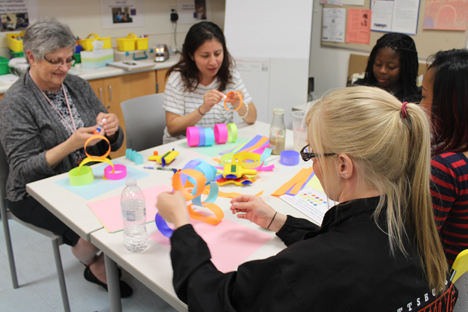Skip to content
To prepare for this course well in advance of the start date, you will need to:
- Classroom seating that allows students to work in groups is a must. Tables that seat 4-6 students are ideal, but small groups of desks can be clustered together. Extra tables and floor space are helpful. Teaching in the campus Lab School is another option for some instructors.
- A projector (with speakers) and screen at the front of the room are essential. Internet access is required for video links.
- Submit an order through your college’s textbook ordering procedures for the textbook: Big Ideas of Early Mathematics: What Teachers of Young Children Need to Know (Practical Resources in ECE) 1st Edition by The Early Math Collaborative - Erikson Institute (Author) ISBN-13: 978-0132946971
- Many campuses offer on-site copy services to prepare student readers. Others may contract with a local vendor. Find out what services are available to submit your copy request. Review the suggested Course Reader and make any desired modifications. When ordering copies, you may wish to request page numbering to be added (if available) to make reference to specific articles easier. Request that the Reader be 3-hole punched and held together with a metal brad or other type of fastener. This way, students can put their course readers into their 3-ring binders.
- Provide copy service desk with the master exemplar activity pdfs or hard copies. Each student will need a set of the 11 exemplars. Request that exemplars are copied on 11”x17” paper, and folded into folio format. Color is highly recommended. Request the folios to be 3-hole punched so students can put them into their binders. If possible, have the exemplars packaged in sets and either placed at the end of the Reader, or purchased by students as a separate resource.
- Use the Master Materials List to determine which items you already have, which you may need to purchase and which you can arrange to borrow from a preschool or childcare center. If you have a Lab School on campus, they will likely be able to loan some items, such as sensory tubs, water play tools, and Unifix® cubes. Some instructors find it helpful to assemble table baskets of frequently used supplies to place on table at each class such as tape, scissors, markers, post-its, and magnifying lenses.
Closer to course start date:
- At some colleges, there may not be a large demand for “elective” curriculum courses in the early childhood program. Because Early Learning in Math and Science is a specialization course, some colleges offer it biennially to allow for pent up demand. Marketing the course availability to beyond the student population to teachers currently working in the field, such as local school districts and the early childhood community, will invite child care professionals, Transitional Kindergarten (in California) and Kindergarten teachers to also enroll for professional growth hours.
- Examples of these documents are provided in Microsoft Word .doc file format so you can easily edit them to reflect your personal information, course policies and required departmental information. Note: Best practice is to provide students with PDF versions of documents in your course for ease and convenience of downloading and printing, and reading in a web browser or mobile device.
- Giving yourself plenty of time to review the instructor guides and PowerPoints ahead of time will let you be more thoughtful about any adaptations you wish to make. The PowerPoint presentations are intended to be completely editable and customizable. You may want to add your own presenter notes that you deem relevant from either the Instructor Guide or your own ideas and areas of focus. Note: In order to properly view the PowerPoints, you need to download them from the website. Format is pptx.; PowerPoint 2010. To help ensure that a presentation created in newer versions of PowerPoint functions correctly when viewed in PowerPoint versions earlier than 2007, turn on compatibility mode. Compatibility mode helps ensure you can work with an older presentation format (.ppt) in PowerPoint 2007 or later.
- Take some time to explore Big Ideas of Early Mathematics: What Teachers of Young Children Need to Know textbook and the Early Math Collaborative website, particularly the Idea Library. The resources on the website (research articles, videos, activity ideas) complement the course textbook and can be very helpful to both instructors and students who want to dive deeper into certain areas of the math content covered in the course.
